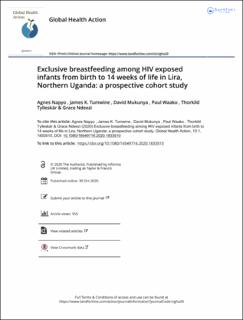| dc.description.abstract | Background
Breastfeeding is important for growth, development and survival of HIV exposed infants. Exclusive breastfeeding reduces the risk of morbidity, mortality and increases HIV free survival of infants. Evidence on risk factors for inappropriate breastfeeding in Northern Uganda is limited.
Objective
This study determined the risk factors for non-exclusivity of breastfeeding in the first 14 weeks of life.
Methods
This prospective cohort study was conducted among 466 mother-infant pairs between August 2018 and February 2020 in Lira district, Northern Uganda. HIV infected pregnant women were enrolled and followed up at delivery, 6- and 14- weeks postpartum. We used a structured questionnaire to obtain data on socio-demographic, reproductive-related, HIV-related characteristics and exclusive breastfeeding. Data were analysed using Stata version 14.0 (StataCorp, College Station, Texas, USA.). We estimated adjusted risk ratios using modified Poisson regression models.
Results
The proportion of HIV exposed infants that were exclusively breastfed reduced with increasing age. Risk factors for non-exclusive breastfeeding included infants being born to HIV infected women who: were in the highest socioeconomic strata (adjusted risk ratio = 1.5, 95%CI: 1.01– 2.1), whose delivery was supervised by a non-health worker (adjusted risk ratio = 1.6, 95%CI: 1.01– 2.7) and who had not adhered to their ART during pregnancy (adjusted risk ratio = 1.3, 95%CI: 1.01– 1.7).
Conclusions
HIV infected women: with highest socioeconomic status, whose delivery was not supervised by a health worker and who did not adhere to ART were less likely to practice exclusive breastfeeding. We recommend ART adherence and infant feeding counselling to be emphasised among HIV infected women who are at risk of having a home delivery, those with poor ART adherence and those of higher socioeconomic status. We also recommend integration of these services into other settings like homes, community and work places instead of limiting them to hospital settings.
Abbreviations
HIV: Human Immunodeficiency Virus; ART: Antiretroviral therapy; HEI: HIV exposed infant; PMTCT: Prevention of mother-to-child transmission of HIV; MTCT: Mother-to-child transmission of HIV; AFASS: Acceptable, Feasible, Affordable, Sustainable and Safe; LRRH: Lira regional referral hospital; CI: confidence interval; ARR: Adjusted risk ratio; SD: Standard deviation; PCA: Principal component analysis | en_US |

